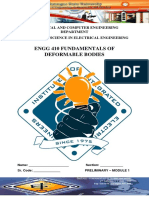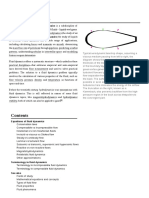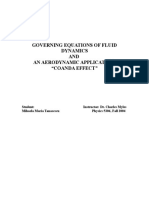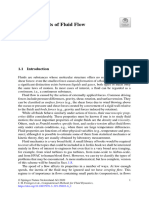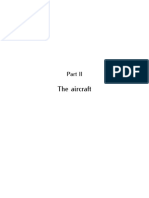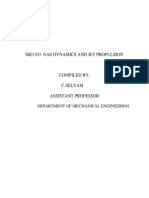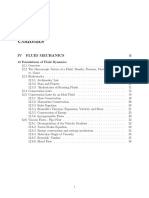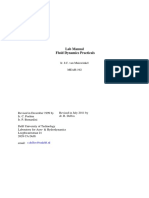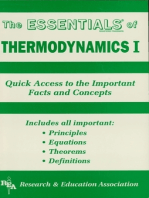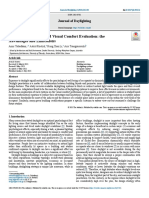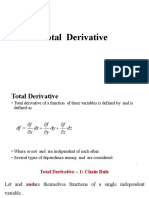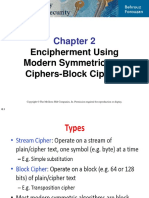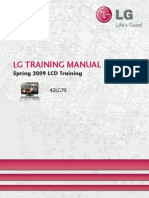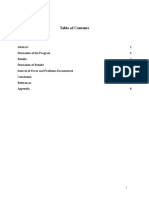DE511 - 1083 - Lesson 2 - PPT
Uploaded by
KumarDE511 - 1083 - Lesson 2 - PPT
Uploaded by
KumarDESIGNED AND DEVELOPED UNDER THE AEGIS OF
NAHEP Component-2 Project “Investments In ICAR Leadership In Agricultural Higher Education”
Division of Computer Applications
ICAR-Indian Agricultural Statistics Research Institute
Course Details
Course Name Dairy And Food Engineering-I
Unit IV
Lesson 2 Hydrodynamic characteristics
Disclaimer : Presentations are intended for educational purposes only and do not replace independent professional
judgement. Statement of fact and opinions expressed are those of the presenter individually and are not the opinion or
position of ICAR-IASRI. ICAR-IASRI does not endorse or approve, and assumes no responsibility for the content, accuracy or
completeness of the information presented.
1
Created by
Name Role University
Tamil Nadu Veterinary and Animal
DR. KARTHIAYANI ARULSELVAM Content Creator
Sciences University, Chennai
Chhattisgarh Kamdhenu
SUDHIR UPRIT Course Reviewer
Vishvavidyalaya, Durg
2
Glossary of Terms
• Aerodynamics is the study of the motion of air, particularly when
affected by a solid object, such as an airplane wing. It is a sub-field
of fluid dynamics and gas dynamics and many aspects of aerodynamics
theory are common to these fields. The term aerodynamics is often used
synonymously with gas dynamics, the difference being that "gas
dynamics" applies to the study of the motion of all gases including air.
• Forces of flight: Aerodynamics is the way objects move through air.
Anything that moves through air is affected by aerodynamics and
explained by four forces of flight viz., lift, weight, thrust and drag.
• Lift: Lift is the push that lets something move up. It is the force that is
the opposite of weight. Everything that flies must have lift.
Glossary of Terms
• Hydrodynamics: A branch of physics that deals with the motion of
fluids and the forces acting on solid bodies immersed in fluids and in
motion relative to them.
• Hydrostatics: A branch of physics that deals with the characteristics
of fluids at rest and especially with the pressure in a fluid or exerted by
a fluid on an immersed body.
Introduction
• In physics and Engineering, fluid dynamics is a sub discipline of fluid
mechanics that describes the flow of fluids viz., liquids and gases.
• It has several sub-disciplines, including aerodynamics (the study of air
and other gases in motion) and hydrodynamics (the study of liquids
in motion).
• Fluid dynamics offers a systematic structure, which underlies
these practical disciplines that embraces empirical and semi-empirical
laws derived from flow measurement and used to solve practical
problems.
• The solution to a fluid dynamics problem typically involves the
calculation of various properties of the fluid, such as flow velocity,
pressure, density and temperature as functions of space and time.
Principles of hydrodynamics
Conservation laws
• Three conservation laws are used to solve fluid dynamics problems,
and may be written in integral or differential form.
• The conservation laws may be applied to a region of the flow called
a control volume. A control volume is a discrete volume in space
through which fluid is assumed to flow.
• The integral formulations of the conservation laws are used to describe
the change of mass, momentum, or energy within the control volume.
• Differential formulations of the conservation laws apply Stokes'
theorem to yield an expression which may be interpreted as the integral
form of the law applied to an infinitesimally small volume (at a point)
within the flow.
Mass continuity (conservation of mass)
• The rate of change of fluid mass inside a control volume must be equal
to the net rate of fluid flow into the volume.
• Physically, this statement requires that mass is neither created nor
destroyed in the control volume, and can be translated into the integral
form of the continuity equation:
• Where, ρ is the fluid density, u is the flow velocity vector, and t is
time.
Mass continuity (conservation of mass)
• The left-hand side of the above expression is the rate of increase of
mass within the volume and contains a triple integral over the control
volume, whereas the right-hand side contains an integration over the
surface of the control volume of mass contained into the system.
• Mass flow into the system is accounted as positive and since the
normal vector to the surface is opposite the sense of flow into the
system the term is negated.
• The differential form of the continuity equation is, by the divergence
theorem:
Conservation of momentum
• Newton's second law of motion applied to a control volume, is a
statement that any change in momentum of the fluid within that control
volume will be due to the net flow of momentum into the volume and
the action of external forces acting on the fluid within the volume.
• In the above integral formulation of this equation, the term on the left is
the net change of momentum within the volume.
• The first term on the right is the net rate at which momentum is
converted into the volume.
• The second term on the right is the force due to pressure on the volume's
surfaces.
• The first two terms on the right are negated since momentum entering the
system is accounted as positive, and the normal is opposite the direction of the
velocity u and pressure forces.
• The third term on the right is the net acceleration of the mass within the
volume due to any body forces (here represented by fbody).
• Surface forces, such as viscous forces, are represented by Fsurf, the net force
due to shear forces acting on the volume surface.
• The momentum balance can also be written for a moving control volume.
• The following is the differential form of the momentum conservation
equation. Here, the volume is reduced to an infinitesimally small point, and
both surface and body forces are accounted for in one total force, F.
• For example, F may be expanded into an expression for the frictional and
gravitational forces acting at a point in a flow.
• In aerodynamics, air is assumed to be a Newtonian fluid, which posits a
linear relationship between the shear stress (due to internal friction
forces) and the rate of strain of the fluid.
• The equation above is a vector equation in a three-dimensional flow, but
it can be expressed as three scalar equations in three coordinate
directions.
• The conservation of momentum equations for the compressible, viscous
flow case are called the Navier–Stokes equations.
Conservation of energy
• Although energy can be converted from one form to another, the
total energy in a closed system remains constant.
• Where, h is the specific enthalpy, k is the thermal conductivity of the
fluid, T is temperature, and Φ is the viscous dissipation function.
• The viscous dissipation function governs the rate at which mechanical
energy of the flow is converted to heat.
• The second law of thermodynamics requires that the dissipation term is
always positive: viscosity cannot create energy within the control
volume. The expression on the left side is a material derivative.
Flow classifications
Compressible versus incompressible flow
• All fluids are compressible to an extent; that is, changes in pressure or
temperature cause changes in density.
• However, in many situations the changes in pressure and temperature
are sufficiently small that the changes in density are negligible.
• In this case the flow can be modeled as an incompressible flow.
Otherwise, the more general compressible flow equations must be
used.
• Mathematically, incompressibility is expressed by saying that the
density ρ of a fluid parcel does not change as it moves in the flow
field, that is
Flow classifications
• where D/Dt is the material derivative, which is the sum
of local and convective derivatives. This additional constraint simplifies the
governing equations, especially in the case when the fluid has a uniform
density.
• For flow of gases, to determine whether to use compressible or
incompressible fluid dynamics, the Mach number of the flow is evaluated.
• As a rough guide, compressible effects can be ignored at Mach numbers
below approximately 0.3.
• For liquids, whether the incompressible assumption is valid depends on the
fluid properties (specifically the critical pressure and temperature of the
fluid) and the flow conditions (how close to the critical pressure the actual
flow pressure becomes).
• Acoustic problems always require allowing compressibility since sound
waves are compression waves involving changes in pressure and density of
the medium through which they propagate.
Newtonian versus non-Newtonian fluids
• All fluids are viscous, meaning that they exert some resistance to deformation:
neighbouring parcels of fluid moving at different velocities exert viscous
forces on each other.
• The velocity gradient is referred to as a strain rate; it has dimensions T−1. Sir
Isaac Newton showed that for many familiar fluids such as water and air,
the stress due to these viscous forces is linearly related to the strain rate.
• Such fluids are called Newtonian fluids. The coefficient of proportionality is
called the fluid's viscosity; for Newtonian fluids, it is a fluid property that is
independent of the strain rate.
• Non-Newtonian fluids have a more complicated, non-linear stress-strain
behaviour. The sub-discipline of rheology describes the stress-strain
behaviours of such fluids, which include emulsions and slurries,
some viscoelastic materials such as blood and some polymers, and sticky
liquids such as latex, honey and lubricants.
Inviscid versus viscous versus Stokes flow
• The dynamic of fluid parcels is described with the help of Newtons
second law
• An accelerating parcel of fluid is subject to inertial effects.
The Reynolds number characterizes the magnitude of inertial effects
compared to the magnitude of viscous effects.
• A low Reynolds number (Re ≪ 1) indicates that viscous forces are very
strong compared to inertial forces. In such cases, inertial forces are
sometimes neglected; this flow regime is called Stokes or creeping flow.
• In contrast, high Reynolds numbers (Re ≫ 1) indicate that the inertial
effects have more effect on the velocity field than the viscous (friction)
effects.
• In high Reynolds number flows, the flow is often modeled as an inviscid
flow , an approximation in which viscosity is completely neglected.
• Eliminating viscosity allows the Stokes equation to be simplified into the
Eulers Equation.
• The integration of the Euler equations along a streamline in an inviscid
flow yields Bernoulli’s Equation.
• When, in addition to being inviscid, the flow is irrotational
everywhere, Bernoulli's equation can completely describe the flow
everywhere. Such flows are called potential flow, because the velocity
field may be expressed as the gradient of a potential energy
expression.
• This idea can work fairly well when the Reynolds number is high.
• However, problems such as those involving solid boundaries may
require that the viscosity be included.
• Viscosity cannot be neglected near solid boundaries because the no-
slip condition generates a thin region of large strain rate, the boundary
layer, in which viscosity effects dominate and which thus generates
vorticity.
• Therefore, to calculate net forces on bodies (such as wings), viscous
flow equations must be used: inviscid flow theory fails to predict drag
forces in this case.
Steady versus unsteady flow
• A flow that is not a function of time is called steady flow. Steady-state
flow refers to the condition where the fluid properties at a point in the
system do not change over time.
• Time dependent flow is known as unsteady (also called transient).
Whether a particular flow is steady or unsteady, can depend on the chosen
frame of reference.
• For instance, laminar flow over a sphere is steady in the frame of
reference that is stationary with respect to the sphere.
• In a frame of reference that is stationary with respect to a background
flow, the flow is unsteady.
• Turbulant flows are unsteady by definition. A turbulent flow can,
however, be statistically stationary.
• The random velocity field U(x, t) is statistically stationary if all
statistics are invariant under a shift in time.
• This roughly means that all statistical properties are constant in time.
Often, the mean field is the object of interest, and this is constant too
in a statistically stationary flow.
• Steady flows are often more tractable than otherwise similar unsteady
flows.
• The governing equations of a steady problem have one dimension
fewer (time) than the governing equations of the same problem
without taking advantage of the steadiness of the flow field.
Laminar versus turbulent flow
• Turbulence is flow characterized by recirculation, eddies, and
apparent randomness. Flow in which turbulence is not exhibited is
called laminar.
• The presence of eddies or recirculation alone does not necessarily indicate
turbulent flow ;these phenomena may be present in laminar flow as well.
• Mathematically, turbulent flow is often represented via a Reynolds
decomposition, in which the flow is broken down into the sum of
an average component and a perturbation component.
• It is believed that turbulent flows can be described well through the use of
the Navier–Stokes equations.
• Direct numerical simulation (DNS), based on the Navier–Stokes equations,
makes it possible to simulate turbulent flows at moderate Reynolds numbers.
• Restrictions depend on the power of the computer used and the efficiency of
the solution algorithm.
• The results of DNS have been found to agree well with experimental data
for some flows.
• Most flows of interest have Reynolds numbers much too high for DNS to
be a viable option, given the state of computational power for the next
few decades.
• Reynoldsaveraged Navier–Stokes equations (RANS) combined
with turbulence modelling provides a model of the effects of the
turbulent flow.
• Such a modelling mainly provides the additional momentum transfer by
the Reynolds stresses, although the turbulence also enhances
the heat and mass transfer.
• Another promising methodology is large eddy simulation (LES),
especially in the guise of detached eddy simulation (DES)which is a
combination of RANS turbulence modelling and large eddy simulation.
Bernoulli's Theorem
• Bernoulli's theorem is essentially a formulation of the mechanical
concept that the work done on a body is equal to the change in its
mechanical energy, in the case that mechanical energy is conserved;
that is, where there is no loss of mechanical energy due to friction.
• Let us consider the motion of an incompressible fluid of density
along an imaginary tube bounded by streamlinessuch a tube a stream
tube.
• Since each streamline represents the direction of motion of a particle
of liquid in steady flow, no particle of liquid may cross a streamtube.
• At the left-hand end of the tube, the liquid has a velocity V1, the tube
has cross-sectional area A1, the pressure is P1, and the tube is at a
height h1 above some reference level. (Fig.1)
• At the right-hand end of the tube, the velocity
is V2, the cross-sectional area is A2 , the
pressure is P2 , and the height is h2 .
• When a small quantity of fluid of volume V is
moved into the tube through the action of the
external fluid, an equal volume of fluid must
emerge from the stream tube against the force
exerted by the pressure P2 of the fluid outside Fig.1: Bernoulli’s theorem
the tube at the right-hand end of the stream
tube.
• Let us imagine that the flow of fluid in the stream tube takes place as
the result of the displacement s1 of a piston of area Al which just fits
the stream tube at its left-hand end such that the volume swept out by
the motion of the piston is A1s1 =V, and of a corresponding
displacement s2 of a piston of area A2 which just fits the stream tube
at its right-hand end such that the volume swept out by the second
piston is A2 s2 = V; that is, a quantity of fluid of volume V has just
passed through the stream tube.
• The piston at position 1 has done work on the fluid equal to the
product of the force exerted by the displacement of that force, hence
the work done onthe fluid is P1A1sl, while the fluid has pushed back
the piston at position 2 so that the fluid has done work on the second
piston of amount P2A2 s2.
• The net work done on the fluid is therefore equal to P1A1s1 = P2A2
s2 (Fig.1)
• Since we have assumed the fluid to be incompressible, we have A1s1 = A2
s2 = V
• From the above equations, we find that the net work done on the fluid
within the stream tubeis P1V - P2V.
• If there was no loss of energy of the fluid due to frictional forces, this work
done on the fluid in the stream tube must have resulted in a change of
mechanical energy of the liquid which flowed into the tube at position 1
and out of the tube at position 2.
• The sum of the potential and kinetic energies of the liquid flowing into the
tube at position 1 is ρVgh1 + ¾ ρVv21, while the sum of these energies of
the liquid flowing out of the tube at position 2 is ρVgh2 + ¾ ρVv22 .
• Equating the work done on the fluid to the difference in its energy, we
find
• Dividing the equation through by V and transposing all quantities with
subscript 1 to the left-hand side and all quantities with subscript 2 to the
right-hand side of the equation, we find
• This equation expresses Bernoulli's theorem, which states that at any two
points along a streamline the sum of the pressure, the potential energy of
a unit volume of fluid, and the kinetic energy of a unit volume of fluid
has the same value.
• As indicated in the derivation, Bernoulli's theorem holds rigorously only
for frictionless, incompressible, streamline flow.
• Bernoulli's theorem is a statement of the principle of conservation of
energy expressed in a form suited to the description of fluids in steady
frictionless flow.
Venturi effect
• Consider now the incompressible flow of a fluid in the geometry. As
we shall only be interested in the average velocity or pressure of the
fluid across a cross section of the tube, the flow is effectively one-
dimensional. (Fig.2)
• The conservation of the mass flow rate in the tube, which represents
the integral formulation of the continuity equation, leads to ρSv1 = ρs
v2, i.e. v2 = (S/s)v1 > v1, with S andsare the area of the tube cross
section in its broad and narrow sectionrespectively. On the other hand,
the Bernoulli equation at constant height, and thus potential energy,
gives
All in all, the pressure in the narrow section is thus smaller than in the
broad section, P2 < P1, which constitutes the Venturi effect. Using mass
conservation and the Bernoulli equation, one can express v1 or v2 in terms
of the tube cross section areas and the pressure difference. For instance, the
mass flow rate reads
Pitot tube
• Flow of a fluid around a Pitot tube, (p) which is a device used to estimate a
flow velocity through the measurement of a pressure difference. Three
streamlines are shown in Fig.3, starting far away from the Pitot tube, where
the flow is (approximately) uniform and has the velocity ~v, which one
wants to measure. The flow is assumed to be incompressible
Fig.3: Pitot tube
• The Pitot tube consists of two long thin concentric tubes: Despite the
presence of the hole at the end point I, the flow does not penetrate in the
inner tube, so that ~vI = ~0 to a good approximation.
• In the broader tube, there is a hole at a point A, which is far enough from I
to ensure that the fluid flow in the vicinity of A is no longer perturbed by
the extremity of the tube: ~vA =~vA0 '~v, where the second identity holds
thanks to the thinness of the tube, which thus perturbs the flow properties
minimally.
• In addition, the pressure in the broader tube is uniform, so that P = PB.
• If one neglects the height differences which is a posteriori justified by the
numerical values we shall find the (incompressible) Bernoulli equation
gives first
Hydrodynamic properties:
• Three important hydrodynamic properties include translational frictional
coefficient, rotational frictional coefficient and intrinsic viscosity.
• The Translational Friction component represents friction in contact
between sliding bodies. The friction is a smooth function of the relative
velocity of the two flanges. This friction approximates the sum of Stribeck
friction, Coulomb friction, and damping.
• The Rotational Friction represents friction in contact between rotating
bodies. The friction torque is simulated as a function of relative velocity and
is assumed to be the sum of Stribeck, Coulomb, and viscous components.
• Intrinsic viscosity: is a measure of a solute's contribution to
the viscosity of a solution. It should not be confused with inherent
viscosity, which is the ratio of the natural logarithm of the relative viscosity
to the mass concentration of the polymer.
THANK YOU
You might also like
- A. R. Paterson A First Course in Fluid Dynamics89% (9)A. R. Paterson A First Course in Fluid Dynamics535 pages
- James A. Fay - Introduction To Fluid Mechanics-The MIT Press (1994)No ratings yetJames A. Fay - Introduction To Fluid Mechanics-The MIT Press (1994)616 pages
- Introduction To Fluid Mechanics by James A. FayNo ratings yetIntroduction To Fluid Mechanics by James A. Fay616 pages
- Module 1 Fundamentals of Deformable Bodies StressNo ratings yetModule 1 Fundamentals of Deformable Bodies Stress15 pages
- (ICP Fluid Mechanics) Guido Buresti - Elements of Fluid Dynamics-Imperial College Press (2012) PDF100% (1)(ICP Fluid Mechanics) Guido Buresti - Elements of Fluid Dynamics-Imperial College Press (2012) PDF602 pages
- Governing Equations of Fluid Dynamics AND An Aerodynamic Application: "Coanda Effect"No ratings yetGoverning Equations of Fluid Dynamics AND An Aerodynamic Application: "Coanda Effect"11 pages
- Transport Phenomena From Biological ProcessesNo ratings yetTransport Phenomena From Biological Processes22 pages
- 2-The AIRCRAFT Fundamentals Aerospace Engineering Soler 2014No ratings yet2-The AIRCRAFT Fundamentals Aerospace Engineering Soler 2014186 pages
- Hydropower and Hydroturbines - Student HandoutNo ratings yetHydropower and Hydroturbines - Student Handout69 pages
- Up-To-date Lecture Presentation Slides For Fluid DynamicsNo ratings yetUp-To-date Lecture Presentation Slides For Fluid Dynamics84 pages
- Hydrodynamics and Aerodynamics - MG - Lec3100% (1)Hydrodynamics and Aerodynamics - MG - Lec324 pages
- MECH 4610 Introduction To Aerodynamics Fall 2014 Preliminary Test of Background KnowledgeNo ratings yetMECH 4610 Introduction To Aerodynamics Fall 2014 Preliminary Test of Background Knowledge4 pages
- Coefficient of Dynamic Viscosity Is Defined As The Shear Force, Per Unit 2. Kinematic Viscosity Is Defined As The Ratio of Dynamic Viscosity To MassNo ratings yetCoefficient of Dynamic Viscosity Is Defined As The Shear Force, Per Unit 2. Kinematic Viscosity Is Defined As The Ratio of Dynamic Viscosity To Mass20 pages
- Me1303-Gas Dynamics and Jet Propulsion PDFNo ratings yetMe1303-Gas Dynamics and Jet Propulsion PDF58 pages
- Lab Manual Fluid Dynamics Practicals: Ir. J.C. Van Muiswinkel MEAH-192No ratings yetLab Manual Fluid Dynamics Practicals: Ir. J.C. Van Muiswinkel MEAH-19227 pages
- Me 361/3061 Fluid Mechanics: Chapter 1: Introduction and Basic ConceptsNo ratings yetMe 361/3061 Fluid Mechanics: Chapter 1: Introduction and Basic Concepts21 pages
- Fluid Mechanics III Class Notes (Complete)No ratings yetFluid Mechanics III Class Notes (Complete)66 pages
- Governing Equations Coanda Effect: Phys 5306No ratings yetGoverning Equations Coanda Effect: Phys 530623 pages
- Fluid Mechanics: Introduction and Basic ConceptsNo ratings yetFluid Mechanics: Introduction and Basic Concepts20 pages
- Intermediate Fluid Mechanics First Edition Robert H. Nunn - Download the full ebook now for a seamless reading experienceNo ratings yetIntermediate Fluid Mechanics First Edition Robert H. Nunn - Download the full ebook now for a seamless reading experience82 pages
- Fermentation and Industrial MicrobiologyNo ratings yetFermentation and Industrial Microbiology18 pages
- (Original PDF) Prestressed Concrete 4th Edition by Warner 2024 Scribd Download100% (7)(Original PDF) Prestressed Concrete 4th Edition by Warner 2024 Scribd Download41 pages
- June 2023 (v1) Qp - Paper 1 Caie Maths IgcseNo ratings yetJune 2023 (v1) Qp - Paper 1 Caie Maths Igcse12 pages
- T e S T P A P e R P R e R M o (C L A S S - I X & X)No ratings yetT e S T P A P e R P R e R M o (C L A S S - I X & X)12 pages
- NPN and PNP Transistors Construction Working and ApplicationsNo ratings yetNPN and PNP Transistors Construction Working and Applications10 pages
- Daylight in Buildings and Visual Comfort Evaluation: The Advantages and LimitationsNo ratings yetDaylight in Buildings and Visual Comfort Evaluation: The Advantages and Limitations23 pages
- Science - Worksheet - Heat - 20170715024044No ratings yetScience - Worksheet - Heat - 201707150240448 pages
- Primavera (P5) Project Management Introductory TutorialNo ratings yetPrimavera (P5) Project Management Introductory Tutorial34 pages
- Encipherment Using Modern Symmetric-Key Ciphers-Block CiphersNo ratings yetEncipherment Using Modern Symmetric-Key Ciphers-Block Ciphers48 pages



